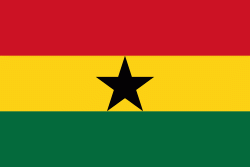Ghanaian cedi
₵
The cedi (currency sign: GH₵; currency code: GHS) is the unit of currency of Ghana. It is the fourth historical and only current legal tender in the Republic of Ghana. One cedi is divided into one hundred pesewas (Gp).After independence, Ghana separated itself from the British West African pound, which was the currency of the British colonies in the region. The new republic's first independent currency was the Ghanaian pound (1958–1965). In 1965, Ghana decided to leave the British colonial monetary system and adopt the widely accepted decimal system. The African name Cedi (1965–1967) was introduced in place of the old British pound system. Ghana's first President Dr. Kwame Nkrumah introduced Cedi notes and Pesewa coins in July 1965 to replace the Ghanaian pounds, shillings and pence. The cedi bore the portrait of the President and was equivalent to eight shillings and four pence (8s 4d), i.e. one hundred old pence, so that 1 pesewa was equal to one penny.
After the February 1966 military coup, the new leaders wanted to remove the face of Nkrumah from the banknotes. The "new cedi" (1967–2007) was worth 1.2 cedis, which made it equal to half of a pound sterling (or ten shillings sterling) at its introduction. Decades of high inflation devalued the new cedi, so that in 2007 the largest of the "new cedi" banknotes, the 20,000 note, had a value of about US$2. The new cedi was gradually phased out in 2007 in favor of the "Ghana cedi" at an exchange rate of 1:10,000. By removing four digits, the Ghana cedi became the highest-denominated currency unit issued in Africa. It has since lost over 90% of its value.
The word cedi is the Akan word for cowry shell. Cowries (plural of cowry) were formerly used as currency in what is now Ghana. The Monetaria moneta or money cowry is not native to West African waters but is a common species in the Indian Ocean. The porcelain-like shells came to West Africa, beginning in the 14th century, through trade with Arab merchants. The first modern coins exclusively used at the Gold Coast were produced in 1796 but cowries were used alongside coins and gold dust as currency until 1901.
Country
-
Ghana
Ghana, officially the Republic of Ghana, is a country in West Africa. It abuts the Gulf of Guinea and the Atlantic Ocean to the south, sharing borders with Ivory Coast in the west, Burkina Faso in the north, and Togo in the east. It covers an area of 238535 km2, spanning biomes that range from coastal savannas to tropical rainforests. With over 32 million inhabitants, Ghana is the second-most populous country in West Africa, after Nigeria.
The Bono state existed in the area that is modern day Ghana during the 11th century. Kingdoms and empires such as Kingdom of Dagbon in the north and the Ashanti Empire in the south emerged over the centuries. Beginning in the 15th century, the Portuguese Empire, followed by other European powers, contested the area for trading rights, until the British ultimately established control of the coast by the 19th century. Following over a century of colonial resistance, the current borders of the country took shape, encompassing 4 separate British colonial territories: Gold Coast, Ashanti, the Northern Territories, and British Togoland. These were unified as an independent dominion within the Commonwealth of Nations. On 6th March 1957, Ghana became the first country in Sub-Saharan Africa to achieve sovereignty. Ghana subsequently became influential in decolonisation efforts and the Pan-African movement.
